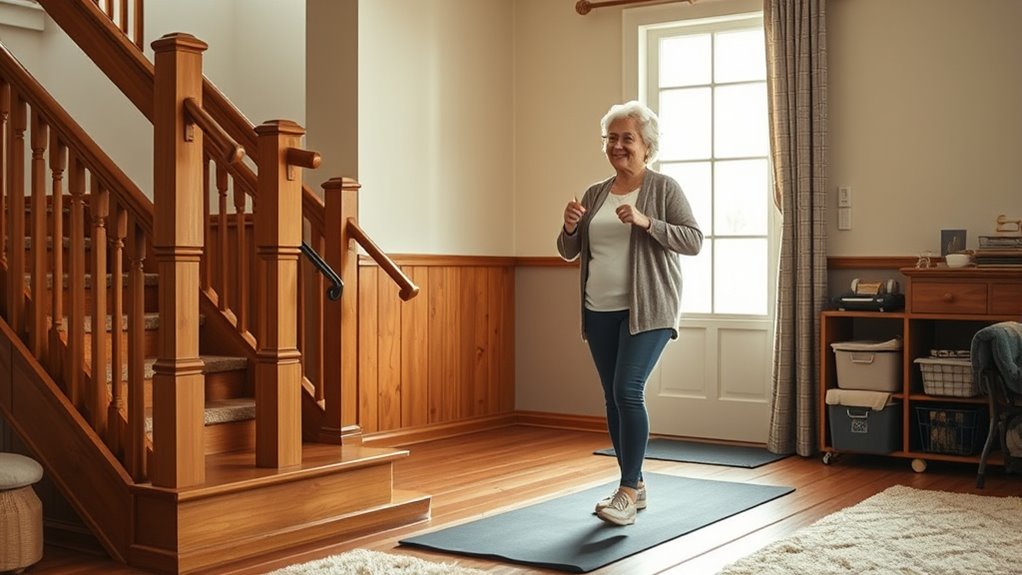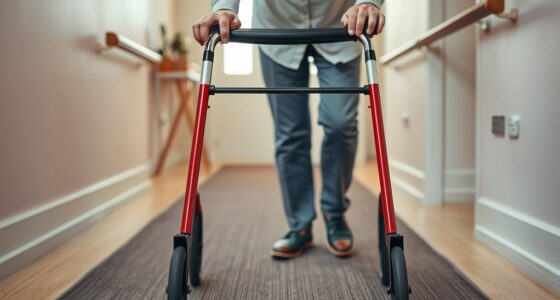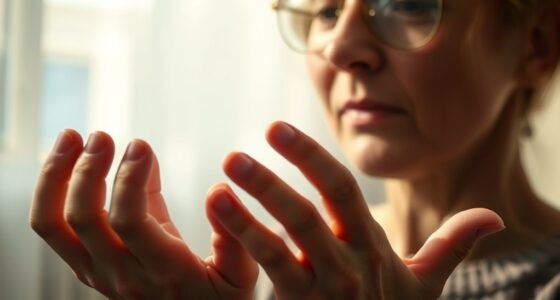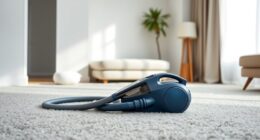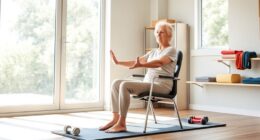To prevent falls at home, stop cluttering pathways, ignoring poor lighting, or relying only on grab bars. Instead, keep walkways clear, install good lighting, and secure rugs with non-slip backing. Don’t forget to maintain secure flooring and use properly fitted assistive devices. Regularly inspect for hazards like loose handrails or uneven surfaces and incorporate balance exercises. Keep these safety habits in mind, and you’ll discover more ways to create a safer living space.
Key Takeaways
- Avoid cluttered, poorly lit pathways; instead, keep walkways clear, well-lit, and add night lights for better visibility.
- Don’t rely solely on good vision; incorporate balance and strength exercises to enhance physical stability.
- Refrain from using loose or damaged assistive devices; ensure they are properly fitted and maintained for safety.
- Do not ignore hazards like uneven flooring or loose rugs; conduct regular safety assessments and prompt repairs.
- Stop neglecting flooring stability; maintain and repair floors to prevent loose tiles, worn surfaces, and water damage.
Avoid Cluttered Pathways and Keep Walkways Clear

To prevent falls, it’s essential to keep your walkways clear of clutter. This means regularly checking for objects that can cause trips, especially near staircases. Staircase vigilance is crucial; always ensure handrails are secure and stairs are free of toys, cords, or loose rugs. Proper footwear safety also plays a vital role—wear sturdy, well-fitting shoes with good grip to avoid slipping on uneven surfaces. Avoid rushing through walkways, especially when carrying items, as this increases the risk of tripping. Keep pathways well-lit so you can see potential hazards. Practicing mindfulness and staying present can also help you notice hazards before they cause harm. By maintaining clear, clutter-free walkways and paying close attention to staircase safety and footwear, you markedly reduce your chances of falling. Staying vigilant ensures a safer environment at home.
Don’t Rely Solely on Grab Bars for Balance

Relying only on grab bars isn’t enough to maintain your balance safely. Improving your overall mobility and using assistive devices properly can make a real difference. These steps help you stay steady and prevent falls more effectively. Incorporating spiritual guidance techniques can also boost confidence and emotional resilience during recovery.
Improve Overall Mobility
Improving your overall mobility is essential for fall prevention, and it goes beyond just using grab bars for support. Engaging in regular mobility exercises can strengthen your muscles, improve flexibility, and boost your balance, making everyday movements safer. Incorporate simple routines like leg lifts, ankle circles, or gentle stretches into your daily schedule. Additionally, wearing adaptive footwear designed for stability and comfort can markedly enhance your gait and reduce the risk of slips or falls. Proper footwear provides better grip and support, especially on slick or uneven surfaces. By focusing on these strategies, you’ll develop better control over your movements, increase confidence, and create a safer environment at home. Remember, maintaining good mobility is a proactive step toward fall prevention.
Use Assistive Devices Properly
While grab bars are helpful, they shouldn’t be your only line of support. Relying solely on them for balance can be risky. Instead, focus on using assistive devices properly to enhance safety. Proper usage of walkers, canes, and other aids guarantees you maintain stability and reduce fall risk. Remember, assistive devices are tools to support your mobility, not crutches for your confidence. To use them effectively: – Ensure your devices are appropriately fitted and in good condition – Practice proper techniques for walking or transferring – Always seek guidance from a healthcare professional on correct usage proper installation and maintenance. Using assistive devices correctly helps you stay balanced and independent, but they work best when combined with good habits and awareness.
Skip Overlooking Proper Lighting in Key Areas
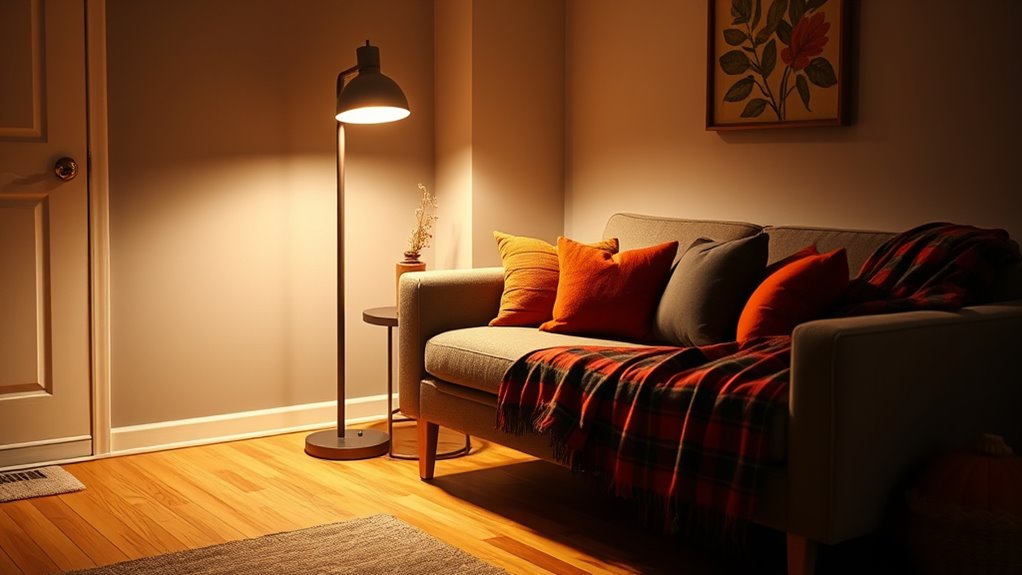
You might not realize how much poor lighting can increase your risk of falling. Brightening dimly lit areas and installing night lights can make a big difference in visibility. These simple steps help you see hazards clearly and move around safely at all times.
Brighten Dimly Lit Areas
Dim lighting in key areas can considerably increase the risk of trips and falls at home. To prevent this, focus on brightening these spaces with effective lighting improvements. Increase bulb brightness and guarantee fixtures are clean and functional. Proper lighting helps you see obstacles clearly, reducing accidents. Consider adding multiple light sources for even coverage and avoiding shadows. Use brighter bulbs in hallways, staircases, and bathrooms where visibility is vital. Installing adjustable fixtures allows you to modify lighting as needed, especially during nighttime. Remember, a well-lit environment enhances safety and confidence.
- Guarantee all bulbs are the correct wattage for each fixture
- Regularly clean light covers to maximize brightness
- Use layered lighting to eliminate shadows and dark corners
- Incorporating layered lighting techniques can further improve visibility and safety throughout your home.
Install Night Lights
Installing night lights is a simple yet effective way to enhance safety during nighttime hours. Proper pathway illumination helps prevent trips and falls by lighting up dark areas around your home. When you do night light installation, focus on key areas like hallways, staircases, bathrooms, and bedrooms. Choose low-wattage bulbs to avoid glare and ensure the light isn’t too bright. Consider plug-in or cordless options for flexibility. Proper placement ensures you can see where you’re going without startling yourself awake. Here’s a quick guide:
| Area | Type of Night Light | Best Placement |
|---|---|---|
| Staircases | Motion-activated | Top and bottom steps |
| Hallways | Plug-in with dimmer | Near doorways |
| Bathrooms | Waterproof LED | Near sink and toilet |
| Bedrooms | Soft bedside lamps | Near bed for easy access |
| Entryways | Portable battery-powered | Near front and back doors |
Additionally, selecting lights with adjustable brightness can help customize illumination levels to suit different needs and reduce unnecessary light pollution.
Stop Ignoring Non-Slip Mats and Rugs That Can Cause Falls
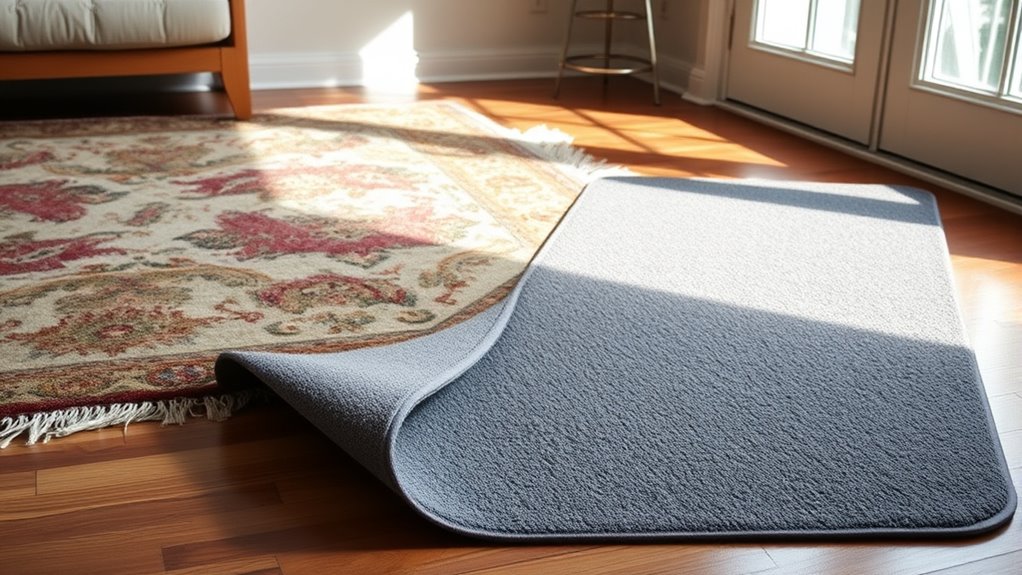
Non-slip mats and rugs are essential safety tools, yet they often get overlooked or dismissed as minor hazards. If they’re not properly secured or chosen with rug safety in mind, they can become tripping risks. Loose edges, worn-out backing, or improper placement can cause slips and falls. To improve safety, consider these tips:
- Use non slip rugs with high-traction backing to prevent sliding.
- Secure rugs with double-sided tape or rug grips to keep them in place.
- Regularly check for wear and tear, replacing worn mats promptly.
- Be mindful of environmental influences like moisture or debris that can reduce rug grip and increase slip hazards.
Ignoring these precautions increases fall risk, especially in high-traffic or wet areas. Prioritize non slip rugs and proper rug safety measures to create a safer home environment and reduce fall hazards effectively.
Don’t Use Worn-Out or Loose Flooring Surfaces
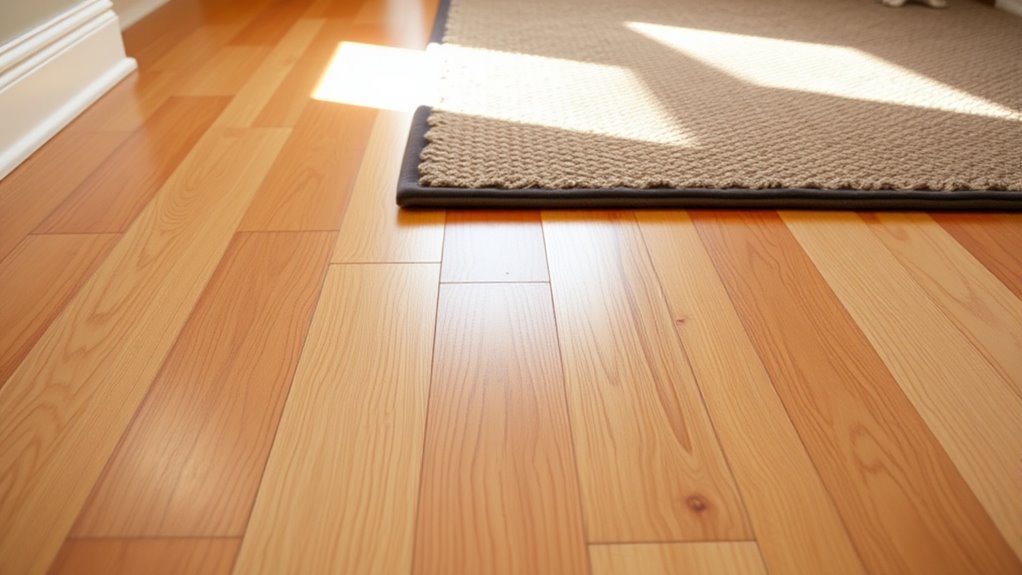
Worn-out or loose flooring can cause dangerous trips and falls, so it’s essential to keep your floors secure. Regularly inspect surfaces for stability and look for areas that need repair or reinforcement. Using proper adhesives and fixing loose spots promptly will help keep your home safe. Incorporating modern shower fixtures can also prevent water damage that may weaken flooring over time.
Secure Flooring Adhesives Needed
To prevent falls at home, it’s essential to make certain your flooring is securely adhered and free from looseness. Using high-quality secure flooring adhesives ensures that tiles, vinyl, or hardwood stay firmly in place, reducing trip hazards. Proper adhesion minimizes movement and creaking, which can cause slips. Consider applying anti slip coatings on surfaces prone to becoming slick, especially in areas like kitchens and bathrooms. Additionally, selecting the right tuning options can help optimize the performance and safety features of your vehicle, indirectly contributing to safer driving conditions.
Remember these key points:
- Choose reliable secure flooring adhesives for lasting bond
- Regularly inspect adhesive integrity and reapply if needed
- Use anti slip coatings to enhance grip in high-risk areas
Maintaining solid adhesion and traction creates a safer environment, preventing falls and giving you peace of mind.
Regularly Inspect Surface Stability
Regularly inspecting your flooring surfaces is essential to maintaining a safe home environment. Conduct routine surface inspections to identify worn-out, loose, or uneven areas that could cause falls. During a stability assessment, check for soft spots, cracks, or loose tiles that may compromise surface integrity. Pay close attention to high-traffic zones and areas prone to moisture, like kitchens and bathrooms. If you notice any signs of wear or instability, repair or replace the affected surfaces promptly. Keeping your floors well-maintained reduces trip hazards and ensures a secure walking surface. Consistent surface inspection helps catch potential issues early, preventing accidents before they happen. Prioritize floor safety through regular assessments, and you’ll create a safer home for everyone. Incorporating digital literacy programs can also promote playful and safe communication among seniors, helping them stay engaged and alert.
Avoid Neglecting Regular Eye Check-Ups and Vision Care

Since your eyesight can change gradually over time, neglecting regular eye check-ups can increase the risk of unnoticed vision problems that may lead to falls. Vision neglect causes you to overlook declining eyesight, which can impair your ability to navigate safely at home. To prevent this, schedule routine eye exams and stay on top of your eye health. Being proactive helps catch issues early and maintain clear vision. Remember:
- Vision neglect can lead to unawareness of worsening eyesight
- Regular check-ups ensure your vision remains sharp and safe
- Addressing eye health reduces fall risk caused by blurred or distorted vision
- Incorporating vision-friendly habits into your daily routine supports long-term eye health
Ignoring eye care puts you at unnecessary risk. Prioritize regular eye exams to keep your vision clear, confident, and fall-free.
Don’t Underestimate the Power of Exercise and Balance Training

Maintaining good vision is essential, but it’s equally important to strengthen your body to prevent falls. Incorporate regular balance exercises and strength training into your routine. Balance exercises, like standing on one foot or heel-to-toe walks, improve stability and coordination. Strength training helps build muscle, which supports your joints and enhances overall mobility. These activities are simple to do at home and can markedly reduce your fall risk. Consistent practice boosts your confidence in daily movements and keeps you agile. Don’t overlook the importance of active engagement—your body needs strength and balance to respond quickly and prevent accidents. Making these exercises part of your routine can make a real difference in maintaining independence and safety.
Refrain From Using Unsecured or Improperly Installed Assistive Devices

Using assistive devices can considerably enhance your safety, but only if they are properly secured and correctly installed. Avoid using assistive devices that are loose, unstable, or improperly installed, as they can cause falls rather than prevent them. Ensuring proper installation is key to making these devices effective.
Properly secured assistive devices are essential for safety and fall prevention.
- Regularly check that handrails, grab bars, and ramps are firmly anchored.
- Follow manufacturer instructions for installation and maintenance.
- Replace or repair any device that shows signs of wear or instability.
Don’t Delay Addressing Hazards Like Loose Handrails or Uneven Surfaces

Addressing hazards like loose handrails or uneven surfaces promptly can prevent serious falls. Regular hazard identification is essential to catch issues before they cause accidents. If you notice a wobbling handrail or cracked steps, don’t postpone repairs. Proactive maintenance keeps your home safe by fixing problems early. Waiting to address these hazards increases the risk of slips, trips, and falls. Make it a habit to inspect your home regularly, especially high-traffic areas and stairways. Fix loose fixtures, level uneven surfaces, and tighten railings as needed. Staying vigilant and taking quick action minimizes fall risks and creates a safer environment. Remember, prompt attention to hazards is a key part of effective fall prevention at home. Don’t wait—act now to protect yourself and loved ones.
Avoid Ignoring the Importance of Routine Home Safety Assessments

Regular home safety assessments are essential because they help you spot potential hazards before they cause accidents. By regularly reviewing your home layout, you can identify risks like cluttered pathways or loose rugs that increase fall chances. Updating your emergency planning ensures you’re prepared for accidents, allowing quick responses that minimize injuries.
Regular safety checks help prevent falls by identifying hazards early and keeping emergency plans up to date.
To make the most of these assessments, focus on:
- Checking for changes in your home layout that could create new hazards
- Ensuring clear, accessible escape routes for emergencies
- Evaluating lighting and installing additional fixtures if needed
Routine assessments keep your environment safe and help you stay proactive in fall prevention. Don’t wait until an accident occurs — regular checks are your best defense.
Frequently Asked Questions
How Often Should I Reassess My Home’s Fall Hazards?
You should reassess your home’s hazards every six months or whenever there’s a change in your health or mobility. Regular hazard assessment keeps your home safety a priority, helping you identify and fix potential fall risks promptly. Make it a routine to check for loose rugs, clutter, or poor lighting, ensuring your environment stays safe and fall-proof. Staying vigilant with hazard assessment protects you and promotes independence at home.
Are There Specific Flooring Materials That Reduce Fall Risk?
You should opt for non-slip flooring and cushioned surfaces, as studies show slip-resistant floors can reduce falls by up to 50%. Materials like vinyl, rubber, or textured carpets provide better traction and absorb impact. These surfaces make a significant difference, especially in high-risk areas like bathrooms and kitchens. By choosing the right flooring, you actively lower your fall risk and create a safer environment at home.
What Are the Best Types of Lighting for Fall Prevention?
You should choose bright, even lighting options like LED or halogen bulbs to reduce fall risks. Opt for bulbs with high brightness, ideally 1000 lumens or more, to guarantee your space is well-lit. Install lighting along hallways, staircases, and entryways, and consider motion-activated lights for convenience. Good lighting eliminates shadows and glare, helping you see clearly and avoid obstacles, making your home safer during fall prevention efforts.
How Can I Encourage Elderly Family Members to Participate in Safety Measures?
You can encourage your elderly family members to participate in safety measures by using motivational strategies that highlight their independence and well-being. Involve family members in safety planning, making it a collaborative effort, and celebrate small successes to boost confidence. Show genuine concern and listen to their worries, making them feel valued. Your active family involvement and positive reinforcement will inspire them to prioritize their safety and stay engaged in fall prevention efforts.
What Affordable Modifications Can I Make to Improve Home Safety?
Are you aware that small, affordable changes can make a big difference? Installing grab bars in the bathroom and adding non-slip mats in showers and on floors are cost-effective safety upgrades. These modifications help prevent falls and boost confidence. You don’t need to spend a lot—simply focus on these simple additions to create a safer environment for your loved ones. Wouldn’t they deserve that peace of mind?
Conclusion
Don’t let falls catch you off guard—think of your home as a fortress that needs constant vigilance. By avoiding hazards and taking proactive steps, you’re not just preventing accidents; you’re safeguarding your independence and peace of mind. Remember, a fall can change everything in an instant. So, take action today—your future self will thank you for creating a safer, more confident home environment. After all, isn’t peace of mind worth every effort?
